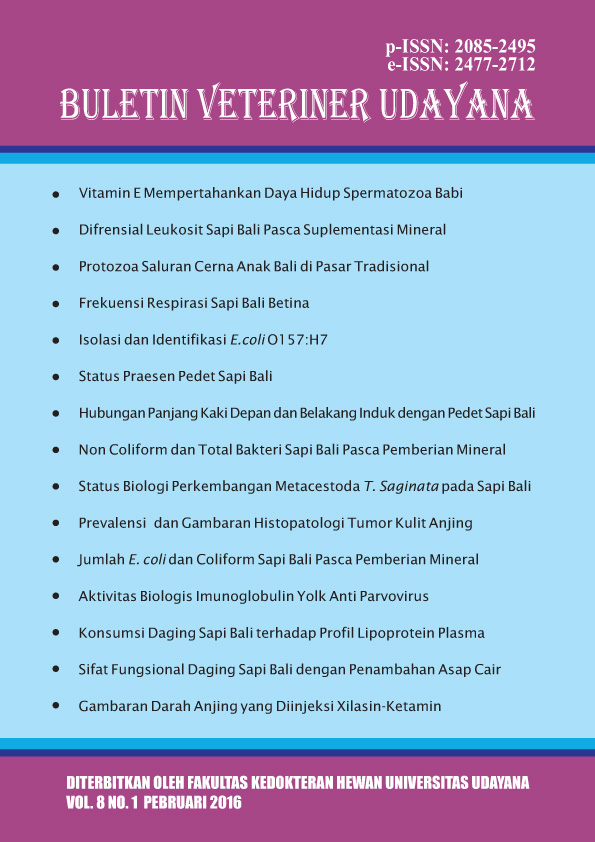rekuensi Respirasi Sapi Bali Betina Dewasa Di Sentra Pembibitan Sapi Bali Desa Sobangan, Kecamatan Mengwi, Kabupaten Badung
Abstrak
Sapi bali betina menjadi salah satu prioritas dalam memperbaiki genetik sapi lokal karena keunggulannya dalam bidang produksi dan reproduksi dibandingkan dengan sapi-sapi lain. Penelitian ini bertujuan untuk mengetahui profil respirasi sapi bali betina dewasa di sentra pembibitan sapi bali Desa Sobangan, Kecamatan Mengwi, Kabupaten Badung yang memiliki rata-rata ketinggian 350 meter di atas permukaan laut serta curah hujan mencapai sekitar 2,029 mm. Penelitian menggunakan 20 ekor sapi bali betina dewasa berumur 1,5 tahun sampai 4 tahun. Pengumpulan data dilakukan dengan melakukan pemeriksaan dan pengamatan pada pagi, siang dan sore hari. Parameter yang diamati adalah frekuensi respirasi. Hasil penelitian diperoleh rataan frekuensi respirasi pagi hari 16,05±0,82 pada suhu lingkungan 25oC, siang hari 20,95±0,88 pada suhu lingkungan 32oC, dan sore hari 19,80±1,57 pada suhu lingkungan 29oC. Hasil ini menunjukkan bahwa frekuensi respirasi pada sapi bali betina dapat berubah sesuai dengan kondisi lingkungan dan faktor pendukung lainnya.
##plugins.generic.usageStats.downloads##
Referensi
Armstrong DV. 1977. Heat stress interaction with shade and cooling. J Dairy Sci, 77: 2044-2050.
Badan Pusat Statistik. 2011. Badung dalam angka tahun 2011. Kabupaten Badung.
Bearden HJ, Fuquay JW and Willard ST. 2004. Applied Animal reproduction. 6thEdition. Pearson Prentice Hall, New Jersey USA.
Broody S. 1996. Climate physiology of cattle. J Dairy Sci, 39(6): 715-725.
Dirksen G, HD Gruender HD, Grunert E, Krause D and Stroeber M. 1979. Clinical examination of cattle. Verlag Paul Parey.
Hafez ESE. 1998. Adaptation of domestic animals. Lea Febiger, Philadelphia. pp. 74-116
Jackson PG and Cockroft PD. 2002. Clinical examination of farm animals. University of Cambridge, UK.
Kadarsih S. 2004. Performance sapi bali berdasarkan ketinggian tempat di daerah transmigrasi Bengkulu: performance pertumbuhan. J Ilmu Pertanian Indonesia, 6(1): 50-56.
Kelly WR. 1984. Veterinary clinical diagnosis. London: Bailliere Tindall.
Kibler HH and Broody S. 1993. Influence of humidity on heat exchange and body temperature regulation in jersey, holstein, brahman and brown swiss cattle. Res. Bull. 552. University of Missouri, Columbia. pp. 1-31.
Linvill DE and Pardue FE. 2002. Heat stressand milk production in the south coastal plains. J Dairy Sci, 75: 2598-2604.
Martojo H. 1990. Upaya pemuliaan dan pelestarian sapi bali untuk menunjang pembangunan peternakan secara nasional. Prosiding Seminar Nasional Sapi Bali, Fakultas Peternakan, Universitas Udayana, Bali, 20-22 September 1990.
Ngadiyono N. 1997. Kinerja dan prospek sapi bali di Indonesia. Seminar-IAEUP Enviromental Pollution and Natural Product and Bali Cattle in Regional Agriculture, Bali.
Purwanto BP, Djafar DM dan Murfi A. 2004. Pengaruh suhu air minum terhadap respons termoregulasi sapi Holstein dara. J. Pengembangan Peternakan Tropis, 2: 16-21.
Robertshaw D. 1995. Heat lost of cattle. stress physiology of livestock Vol II. Mk. Yousef (Ed). CRC Press Inc. Boca Raton, Florida. pp. 55-65.
Santoso SAB, Haryoko B, Purboyo dan Purwanto BP. 2006. Penerimaan panas dan respons termoregulasi sapi dara peranakan fries holstain (PFH) di dalam kandang beratap seng dan rumbia dengan dinding dan tanpa dinding. Proc Pemberdayaan Masyarakat di Bidang Agribisnis untuk Mendukung Ketahanan Pangan. pp: 309-319.
Talib C. 2002. Sapi bali di daerah sumber bibit dan peluang pengembangannya. Wartazoa, 12(3): 100-107.
Widiyono I, Wuryastuti H, Indarjulianto S dan Purnamaningsih H. 2003. Frekuensi nafas, pulsus, dan gerak rumen serta suhu tubuh pada kambing peranakan ettawa selama 3 bulan pertama kehidupan pasca lahir. J Saint Vet, 21(2): 39-42.





